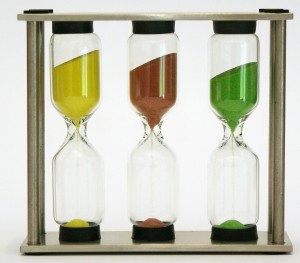 Your production capacity is one important aspect of your production system. The capacity has to match your demand. If your demand is higher than your capacity, then you will not be able to supply the customer. On the other hand, if your capacity is higher than the demand, then you will have lots of idle workers and machines, which is not good either. The name is actually a bit of a misnomer, since capacity is the ability to contain things, whereas for a production system we are much more interested in the number of parts that are completed. In any case, capacity is important!
Your production capacity is one important aspect of your production system. The capacity has to match your demand. If your demand is higher than your capacity, then you will not be able to supply the customer. On the other hand, if your capacity is higher than the demand, then you will have lots of idle workers and machines, which is not good either. The name is actually a bit of a misnomer, since capacity is the ability to contain things, whereas for a production system we are much more interested in the number of parts that are completed. In any case, capacity is important!
The Easy Way: Total Production Quantity During a Time Period
One of the easiest ways to measure capacity is to simply use the total production quantity for a given time period. For example, if your plant can produce an average of 20,000 gizmos per week, then your total capacity is 20,000 gizmos per week. So far, no surprises.
You can also divide the total time by the total quantity, and get what I call the line takt or system takt (see also How to Determine Takt Times). Hence, this system takt is also a measure of the capacity, which has to match the customer takt, a measure of the demand. Confusingly, many practitioners also call this the (average, total, …) cycle time, which I find confusing, as for me the cycle time is without losses, but the takt time includes losses.
What Is My Quantity?

The quantity should be the quantity that you can realistically produce, including all time lost for changeovers, maintenance, breakdowns, missing parts, and other delays. Hence, for a system working at full capacity, it is the average quantity produced in a given time period.
If your system is working at less than capacity, however, you cannot take the total production quantity. For example, if you produced 20,000 gizmos per week, but half of the time your people were idling, then you cannot use the 20,000. Same goes if only half of your people work while the other half idles, or if you fill their time with some secondary tasks like weeding the parking lot (yes, I have seen a plant doing just that).
Now, you could just assume that if half of your people are idling when making 20,000 gizmos per week, then your total capacity would be twice that: 40,000 gizmos. This is probably not true. If there is not enough work around, then people automatically work slower than normal. Hence, your total capacity would be quite likely more than 40,000 per week. This could be 30% on top or more, but this is hard to estimate. The best way is still to take a fully loaded system and count the parts during a given period.
Can I Calculate My Quantity?
 Another possible option is using calculations to determine the total quantity. Some plants use predetermined motion time systems like MTM or REFA to calculate the time a worker needs for the tasks. Others use the cycle time divided by the estimated OEE. Simulation has also been used to measure plant capacity. I generally advise against that. These methods are far too imprecise to give a good estimate of the production capacity. If you have a plant, use real numbers of the plant running at full capacity.
Another possible option is using calculations to determine the total quantity. Some plants use predetermined motion time systems like MTM or REFA to calculate the time a worker needs for the tasks. Others use the cycle time divided by the estimated OEE. Simulation has also been used to measure plant capacity. I generally advise against that. These methods are far too imprecise to give a good estimate of the production capacity. If you have a plant, use real numbers of the plant running at full capacity.
Of course, if you do not (yet) have a plant, you cannot measure the plant (yet). For example, if you build a new greenfield plant, restructure a line, or generally plant to significantly change your system, you can test the capacity only after installation and ramp up. If you need the capacity beforehand, you have to calculate. Keep in mind that this is usually a very imprecise approach. If you have other similar plants, use the experience from these plants when creating your capacity estimates.
Assumption for the Working Time

The working time during a time period should be similar. Your capacity will differ if your plant runs on one shift or two shifts per day. Naturally, if you work longer, you can produce more. This assumption is usually not a problem, since it is simply included in the assumptions. Every foreman worth his money assumes that in two shifts he can make twice the parts as he can make one shift. For practical purposes this is usually also precise enough, even though production during shifts are not necessarily identical.

For example, some night shifts may be more productive since no manager is around to mess things up. Yet, in other plants night shifts may be less productive since no manager is around to keep them working. I have seen people on night shifts sleeping when they should be working. But again, unless you have more detailed data, the assumption of a linear relation between work time and quantity is usually good enough.
For the time, I usually simply take the total available time with people present. For example, if a shift is 7.5 hours, then a five-day work week with one shift is 37.5 hours. In rare cases I have seen plants taking out things like maintenance time or changeovers. This is possible, but not necessary. It all depends on what you use the capacity measurement for. If you make 20,000 gizmos per week without maintenance, then your capacity for the next four weeks is 80,000 gizmos without maintenance. Both sides of the equation have to have the same assumptions for the time. If you calculate capacity during a two-shift week without maintenance times, and then apply it to a two-shift week with maintenance, you will be waaaay off. Just keep it simple.
Assumption for the Work Content

The second assumption is often overlooked – the work content for one part should be similar for all parts. If my capacity is 20,000 gizmos per week, I assume every gizmo takes approximately 1/20,000 of the working time during the week. However, if I have some easy-peasy gizmos that just fly off the line and other heavy-duty gizmos that keep my people busy for hours on end, then I cannot simply just put them together.

If your products have quite different work content, then the calculation becomes more tricky. In fact, usually too tricky for upper management. If your boss asks you what your capacity is for next week, saying, “Either 5,000 large ones or 30,000 small ones or anything in between depending on the mix,” is usually not a career building answer 😉 .
Luckily, you can do an additional assumption of a similar product mix. If you measured your capacity with a certain mix of high- and low-work content products, then this capacity assumption is valid as long as you have a similar product mix. Hence, answering your boss with “20,000, sir,” is a much better career-building answer, with the unspoken underlying assumption of a similar product mix.
Overall, I usually try to assume a similar mix or similar product work content to make my work easier. If both of these assumptions do not hold true, I am forced to do it the hard way.
The Hard Way: More Precise but Cumbersome
If both assumptions of similar work content or similar mix fail, the capacity has to be calculated based on the individual mix. You would need the system takt for the major product (groups) going through the system. In other words, you would need to know the average time between parts for both low-work-content and high-work-content parts, including the losses.
Before calculating the takt times for every single product you make, try to group them into groups with similar work content. This makes it much easier. You will lose a small bit of precision, but this precision is lost anyway due to the fluctuations between otherwise similar weeks.

You then need to calculate the takt of each group. What is the average time between the completion of the parts, including all losses. In other words, assume a small part is completed on average every 5 seconds, and a large one every 20 seconds (i.e., the takt time). You then can simply choose two production quantities, which, multiplied with the takt times, must give you the total work time available. For example, you could make 15,000 small ones in 20.8 hours, and fill the remaining 16.2 hours with 3,000 large ones. Or you make 25,000 small and 500 large for again 37.5 hours total. That way you can calculate the capacity for each mix you would like.
When calculating the takt time (time between parts including losses) for your product groups, keep in mind that many manufacturing systems fluctuate heavily over time. If you get a “good hour,” your result will be quite different from a “bad hour,” as will the capacity estimate. Try to get as much production data as you can. Also make sure to include all losses.
When looking only at the parts per hour, it is easy to overlook longer breakdowns or interruptions where nothing got produced. In other words, assume in the morning you produced 1000 small parts per hour, in the afternoon you did 250 large ones, and in between you had a two-hour maintenance. You need to include the maintenance in the total estimate, ideally proportional to the total production time for small and large parts.
If you can’t measure your work at all …
Sometimes you have products (or services) that vary widely in their work content. Additionally, there may be “surprises” that cause unforeseen work (Changes in design, product doesn’t work yet, production is more difficult than expected …). Overall, you do not really know your work content very well. Now you could manage to standardize your products at least somewhat, although this is often difficult.
If you do lack reliable data about the work content, the best approach is usually an expert estimate. As you surely known, an expert estimate is a wild guess by someone that has at least some familiarity with the system. While this is rather imprecise, for some products it may be the only way to guesstimate the work content and hence the production capacity.
It is still worthwhile, though, to have an upper limit on the quantity or amount of work in the system at the same time. This limit turns your production system into a pull system (see The (True) Difference Between Push and Pull).
Summary
I hope the last parts were not too confusing for you. Again, calculating by product type makes it much more tricky. I myself also much rather prefer the assumption of similar parts or similar product mix. Even if it is a borderline case, I still prefer one of these assumptions over the hassle of getting product-specific data including all losses, and then try to figure out the capacity depending on the mix. Unfortunately, sometimes it cannot be avoided (e.g., if you try to figure out the capacity of a maintenance guy). He can do many small things or a few big things before the end of his shift. It gets even more complex if experienced maintenance guys can do lots of different things, and newer ones not yet. And, all of this doesn’t even include customers that are willing to pay a higher price if there is a (perceived) shortage of goods. In any case, go out and match your capacity to your demand when you organize your industry!
P.S.: The post is based on an interesting question I got from Andy Higgins (name mentioned with permission). Thanks, Andy 🙂

Thanks for that great post.
This the worst explanation of capacity I have ever heard. You should think a little deeper about why you need to understand your capacity, your true theoretical capacity.
Really Helpful, I am working on such a Project in a firm where there is a wide variety of products and now my task is to measure production capacity. Thanks again
Really Helpful, I am working on such a Project in a firm where there is a wide variety of products and now my task is to measure production capacity. Thanks again
Excelent article… I’ve been on this situation that my boss asked me about total capacity. You must be very cold minded and pragmatic to answer that.